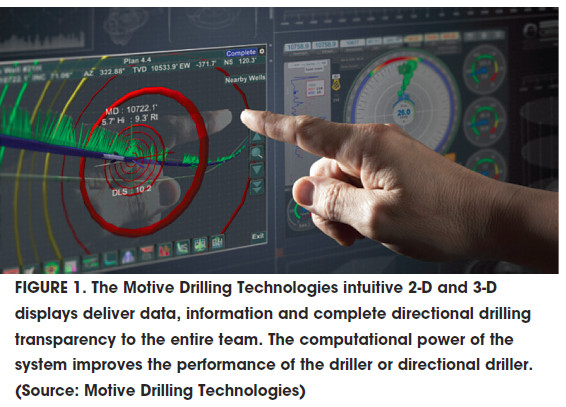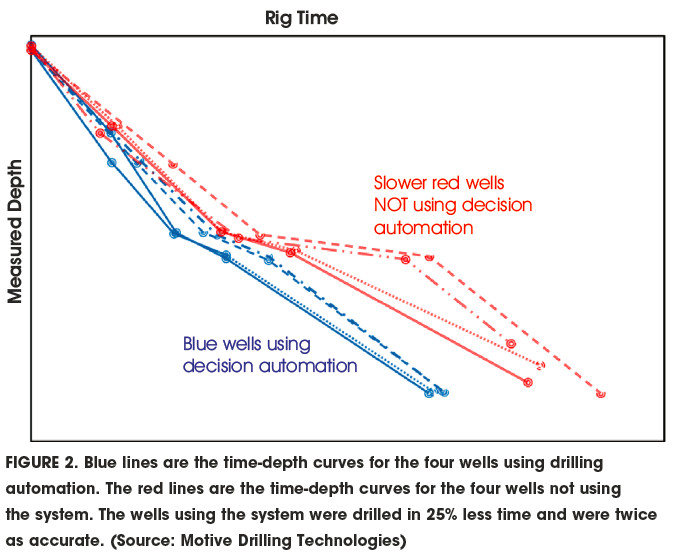One of the most significant problems identified by oil and gas operators in unconventional plays is the inability to follow a prescribed well path consistently and to hit and stay within the targets identified collectively by the company’s geologists, geophysicists and engineers. One reason is that directional drilling technology lags behind other technical advances that drove the tremendous growth in horizontal drilling.
To address this problem, Motive Drilling Technologies developed a directional drilling bit guidance system automating decision-making at the rig. Automated decision-making has been used for making medical decisions; for playing games (such as Jeopardy, chess, poker or the ancient game of Go); for automatically piloting cars and planes; for manufacturing, shipping and missile guidance; and for much more. Over the past five years Motive has applied automated decision-making to its bit guidance system’s development and subsequently to the drilling of more than 610,000 m (2 million feet) of horizontal and extended-reach wells for more than a dozen oil and gas companies across North America. Use of the system has resulted in wells drilled with more consistency in less time, with more accuracy and more production potential and, in some cases, with less personnel (Figure 1).

Drilling rates are so fast that even the best directional drillers simply do not have the time to perform all the necessary calculations required to make the absolute best directional drilling decisions. The performance of directional drillers often is quite variable, costing the industry billions of dollars each year due to slower drilling speed, increased tortuosity and lost production potential.
Need for speed
While drilling horizontal wells, directional drilling experts must make quick decisions determining when to rotate the entire drillstring and when to adjust the direction of the drillstring by sliding. These decisions are based upon numerous inputs, including bit walk tendencies, motor yields, anti-collision guidelines, dogleg severity and future production consequences related to deviation from the target path. In real time the directional driller continuously analyzes data including gamma ray logs, hook load, surface torque, pump pressures, flow rates, trajectory measurements, distance to nearby wells and much more.
Good directional drillers rely upon their expertise developed over many years as apprentices to more experienced drillers. This results in an environment where most directional drilling decisions are made quickly based on the individual’s experience and an acquired intuition. However, the best directional drillers also know when they must move beyond intuition and shift to performing more effortful geometrical computations to make good decisions. Nobel Prize-winning author Daniel Kahneman wrote in his book Thinking Fast and Slow that in many situations humans tend to rely upon intuitive thinking too much. They are not willing or do not have the time or energy to switch to more effortful thinking, even when it is required for better decision-making. This unwillingness to adapt behavior contributes to the large variation in performance often seen while drilling horizontal wells.
Automated process
The bit guidance system developed by Motive uses a high-performance computer to provide a more data-driven automated decision-making process, delivering the necessary improvement in directional drilling performance. As a foundation for better decisions, the system automatically performs standard directional drilling calculations previously done by the directional driller but calculates them continuously and faster than humans are able. In addition, the system provides a tremendous amount of additional analysis and automatically provides the driller with step-by-step slide/rotate guidance based on the dynamic analysis together with parameters set by the operator. The machine can run calculations on millions of possibilities/permutations that a human cannot do, thereby making the best decision to maximize value. The automated decision considers such variables as drilling time, lost-time risk and future production potential. Additionally, tortuosity of the wellbore is factored into each directional decision to reduce torque and drag on the wellbore, enable higher drilling rates, extend the maximum reach of laterals and reduce sumps in the lateral that impact production efficiency. This degree of analysis is rarely even considered by human directional drillers.
The system continuously adjusts the guidance based on driller’s actions and provides real-time feedback to enhance his or her performance. This level of automation consistently improves the driller’s ability to maximize value to the operator independent of experience.
Eagle Ford case study
Figure 2 shows the results of a case study designed to test the system for a client drilling in the Eagle Ford Basin. Two identical rigs were mobilized in the same area and drilled four wells each. One rig used Motive’s decision automation tool, and the other rig drilled the wells without decision automation. All other parameters were the same, including bit, bottomhole assembly and well paths. The rig using automation drilled 25% faster and with twice the accuracy.

The system does not completely automate every single task of the directional driller. But the computational power of the system combined with the experience and intuition of the directional driller provides oil and gas operators with the best opportunity for consistent performance at higher levels while mitigating risk. With the introduction of decision automation, new roles might need to be defined, and an emphasis on change management and new technology acceptance is critical. However, the rewards are great. In addition to the gains in performance on an individual well basis, the expertise of the best directional drillers can be scaled. With the system performing all the heavy computational lifting, a single expert directional driller can guide multiple wells from a single location.
With this distributed system, the entire decision-making team (on the rig and in the office) is continuously informed about past, current and dynamically planned future directional drilling activities using automated dynamic reporting, email and text notifications, freeing the directional driller to perform other tasks. The system provides this transparency through 2-D and 3-D visualization interfaces that are available both through a browser and iPad app.
By providing complete directional drilling transparency to the entire team regardless of location, the system returns operational control back to the operator and provides better utilization of the best directional drillers.
Just as decision automation is helping doctors provide better treatments and cars to be safer, this technology has proven to improve the performance and consistency of drilling horizontal wells in today’s tough environment.
Recommended Reading
Petro-Victory Buys Oil Fields in Brazil’s Potiguar Basin
2025-02-10 - Petro-Victory Energy is growing its footprint in Brazil’s onshore Potiguar Basin with 13 new blocks, the company said Feb. 10.
GeoPark Ends Plans to Purchase Repsol’s Colombian Assets
2025-01-15 - Repsol’s partners exercised their rights to acquire Repsol Colombia O&G Ltd., which included interest in CPO-9 Block and SierraCol Energy Arauca LLC, after the purchase was announced.
Ecopetrol Closes $452MM Deal for Repsol’s Interests in Colombian Block
2025-02-06 - Ecopetrol has completed a deal with Repsol Colombia Oil & Gas Ltd. to acquire its 45% participation interest in CPO-09 Block—assets GeoPark Ltd. had originally proposed buying.
NAPE Panelist: Occidental Shops ~$1B in D-J Basin Minerals Sale
2025-02-05 - Occidental Petroleum is marketing a minerals package in Colorado’s Denver-Julesburg Basin valued at up to $1 billion, according to a panelist at the 2025 NAPE conference.
NOG Spends $67MM on Midland Bolt-On, Ground Game M&A
2025-02-13 - Non-operated specialist Northern Oil & Gas (NOG) is growing in the Midland Basin with a $40 million bolt-on acquisition.
Comments
Add new comment
This conversation is moderated according to Hart Energy community rules. Please read the rules before joining the discussion. If you’re experiencing any technical problems, please contact our customer care team.





